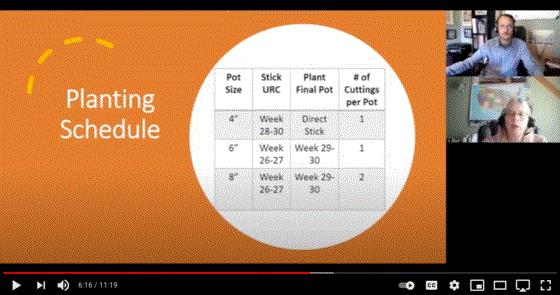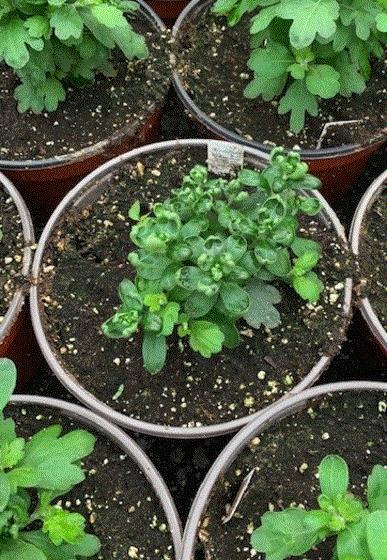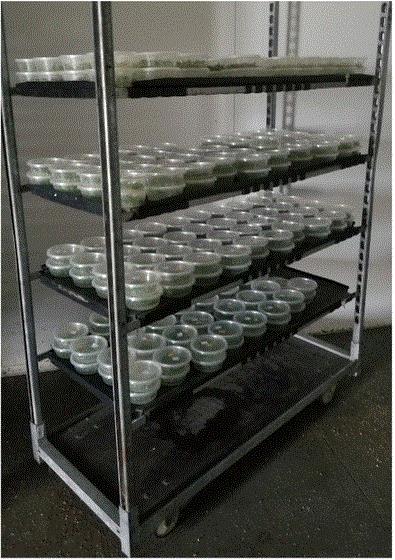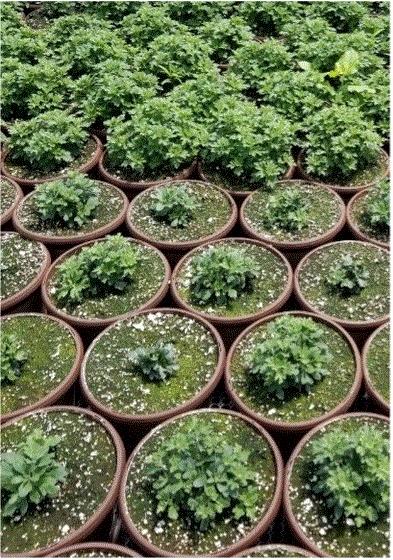Need Mums Fast?
Consumer demand is quite high this year (understatement of the week ...) and all indications point to high interest and demand this fall, as well. Are you ready to fill your customer’s stores with garden mums? If you’re thinking you have just enough, it’s probably time to order more ASAP. And to get them ready in time, you’ll have to move fast.

To help produce a top-notch crop in time to ship during peak season, we created a video with Cindy Drumgool, mum expert/former mum grower/business manager for Ball Mums. In HOW TO FAST-CROP FALL MUMS, Cindy shares the keys to a high-quality crop, three mistakes to avoid, a planting schedule for different finished plant sizes, and a list of suggested mid-season varieties to ensure success.
After you and your team watch the video, download the PRESENTATION SLIDES for reference when putting together your production plan.
Nick’s Tip of the Week: Garden Mum Crown Budding
Each week, I’ll work with my partner in crime Nick Flax, one of the technical services experts at Ball, to share a concern that’s come up during one of his numerous calls with growers across North America. This week he’s all about the chaos surrounding crown budding and garden mums.
PROBLEM: Growers who produce fall garden mums know that short days (well … long nights, really …) are the key to initiating flowering. For anyone growing in the northern US, mid to late September is usually when “natural short days” are achieved—when daylength is less than 12 hours.
However, daylength isn’t the only thing that can cause mums to initiate flowering. Cold night temperatures for a few days can cause premature flowering (a.k.a. crown budding) to occur. Preventing this from happening can be the difference between a high-quality mum crop and a small, finished plant that’s in color WAY too early and won’t make it to the fall when consumers want it.
Night temperatures in the northern US have been as low as the high 40s F since some growers started their mums in late May, and I got a couple of calls this week about crown budding, so let’s dive into the specifics and how to combat this issue.

NICK’S TIP: Whether you’re growing in a greenhouse or outside on a “mum pad,” two to three or more consecutive nights (depending on your varieties’ sensitivity) where temperatures dip into the mid to low 60s F or lower can trigger crown budding. Here are a few strategies that you can use to prevent crown budding or—if the worst should come to pass and crown budding occur—get your mums back on track.
Avoid low-temperature stress. First and foremost, avoid low-temperature stress. Keep an eye on the weather and change your greenhouse controller’s setpoints if a cold snap is coming through. Though we’re in summer and mums can easily withstand late-May and early June night temps without additional heat, you might need to kick the heaters back on for a couple of nights to curb crown budding.
Avoid other stress factors. Drought stress and withholding fertilizer can predispose mums to crown budding. The greater the stress your crops are under, the more likely they will be to prematurely initiate flowering. Think of it this way: if the variety you are growing could normally stay vegetative after four to five cold nights under ideal conditions, a hungry and/or thirsty mum will likely only be able to withstand one to two cold nights before crown budding.
Corrective action. If crown budding occurs despite your best efforts to prevent it using good culture and environment management, there are a couple of strategies you can use to get your crop back on track.
1. If you can catch them early, push them hard with an ammonia-based fertilizer. Give them several thorough, consecutive applications of 20-10-20 at 250+ ppm N (you can even do 20-20-20, but do not use this more than once or twice). This should kick them back into vegetative growth, but plants should be monitored closely until normal growth resumes.
2. If the fertilizer strategy makes you a little nervous or your crop is well on its way to visible buds, an application of ethephon (Florel/Collate) will be the quickest way to stop flowering. This will also encourage additional branching and emergence of new flowering nodes, so your crop will recover with plenty of color to spare! Rates between 500–750 ppm are generally what’s recommended, but ideal rates will vary across varieties. Check the culture info from your supplier, as some varieties are more sensitive to ethephon than others. Also, be sure to check your water quality before mixing and applying ethephon, as the pH of your spray water needs to be lowered to at least 4.5 to 5.0 in order to have any effect.

Scheduling Echinacea for Fall Sales, Plus More Perennial Training
Do you know what goes really well with garden mums in the fall? A lot of different perennials, including echinacea. In this VIDEO, Chris Fifo of Darwin Perennials explains what it takes to grow a beautiful first-year flowering echinacea crop to hit a Labor Day sale date. But to make this happen, you need to get those liners in quick.

In less than five minutes, Chris takes us from planting liners to finishing echinacea using proper scheduling for an outdoor crop, touching on pinching and nutrition in the process. He also discusses how to grow echinaceas for Mother’s Day sales (but you’ll probably want to put that part on the back burner for a few months and focus on maximizing fall sales).
This video was released last year for Darwin Perennials Digital Days, a virtual festival of perennial training. Well, they’re back at it this year with Darwin Perennials University, an all-new approach with content scheduled as once-a-week sessions to bring you up to speed on the latest perennials like salvia, coreopsis, nepeta, lavender and leucanthemum and how to grow them for success. ENROLL NOW to get weekly updates on videos released, as well as a ton more information to up your perennial-growing game.

Tissue Culture Tips
More and more of you are starting plants form tissue culture (TC) and this trend looks to continue to increase in the near future. Here are some quick tips to get you off to a great start.

Handling of tissue culture Stage 3 prior to planting is critical for uniform establishment of the plants. Unpack the plants immediately upon receipt and place in a bright (no direct sunlight) area at 70–75F to encourage plant acclimatization to the new environment. Remember that the plants were grown under high relative humidity and reduced light conditions in the culture flask.
After deflasking, move rapidly to a high humidity area under reduced light (no direct sunglight) to prevent drying out and sunburn. Plants will begin to acclimate to the greenhouse environment within one to five days, depending on variety.
Water management after deflasking is dependent on whether the Stage 3 material has roots or not at the time of sticking. If no roots are present, treat these plants like a URC. But if roots are present, consider treating them more like bareroot products.

Inconsistent Mums?
Check out this photo. What do you think is going on?

The problem here lies in the soil, out of sight and out of mind. The same varieties were planted on the same day, but they ran out of soil and planted into another media. All the plants were fertilized at every other watering and there was slow release in the mix. After four weeks it was clear that the group in the foreground were locked up and not growing.
The media in the foreground had field soil in it that was amended with gypsum, which raised the EC of the soil to 3.0++. And due to mixing inconsistencies, there was 1 to 8 ppm phosphorous in the soil. When excessive gypsum is incorporated in the mix, which results in high salts, it is important to keep the soil moist to minimize the salt effect. With the inadequate P in the mix, the plants will not grow without a P boost. An application of 9-45-15 (contains high P plus micros) will give the plants the kick they need to resume growth, assuming the soil is kept moist.
Rust on Asters
Warning: The following tip is not pretty, and if your aster crop gets as bad as the one below, it's probably heading to the dump pile. I hope this doesn’t happen to you.
Last year, the Tech On Demand crew got this question: What’s causing this severe problem on my aster crop and what can I do about it?

Here’s the answer: This looks like rust, and it’s severe. At this stage, the crop may not recover and affected plants may need to be discarded. Some measures that should have been taken at the first signs include creating good air movement, low humidity, and proper spacing to help prevent the development of rust.
If you see rust, the recommended fungicides are Myclobutanil (Eagle, Systhane) followed by Heritage (or Mural) followed by Terraguard or Bayleton. In addition, the plants can be preventatively treated with Heritage or similar strobilurin. (FYI, Myclobutanil is considered curative (not preventative), so to get the most from this product, it’s best used during an active outbreak.)

Finish Line ...
Meteorological summer (June-August) is here, and that means one of my favorite events is right around the corner: Ball Customer Day. It’s the annual event that’s been held in West Chicago, Illinois for eight decades, offering Ball Seed customers the chance to visit one of the premier trial grounds in North America.
The Gardens at Ball have been expanded greatly over the years, creating not only an opportunity to see hundreds of varieties in action, but also to chat with experts across all areas of horticulture in a beautiful garden setting.

This year, once again join the folks at Ball live and in person during the Ball Seed Customer Days event. REGISTER NOW to visit on one of the THREE days of the event (instead of the usual one) between July 28 and July 30. Catch up with old friends and meet new ones as you tour gardens filled with annuals, perennials, ornamental shrubs, vegetables and more.



As always, my email is bcalkins@ballhort.com if you have any comments, suggestions or challenges we can help solve.

Bill Calkins
Editor - Tech On Demand
This email was received by you and 22,262 other fine subscribers!
If you're interested in advertising in Tech On Demand, contact Kim Brown ASAP and she'll hook you up.